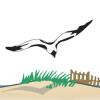Horseshoe crab harvest should not include females
Each spring, horseshoe crabs migrate from the Atlantic Ocean to bay beaches where they deposit billions of eggs. This annual pulse of energy fuels the great global shorebird migrations that have been timed over millennia to coincide with the crabs’ spawning. Fishermen also rely on the crabs as bait and the biomedical industry uses the crabs’ blood to protect us from medical contaminants. Horseshoe crabs are a perfect representation of the interdependence of life on the coast, and right now, they need our help.
Historically, horseshoe crab populations have been decimated by overharvesting. The first overharvest began in the mid-1800s when industrialized harvest for fertilizer dramatically reduced their abundance. The second overharvest occurred during the 1990s when they were collected without limit for use as bait by eel and whelk fishermen. That plunder contributed to steep declines in the populations of migrating shorebirds. In response, the Atlantic States Marine Fisheries Commission regulated the horseshoe crab for the first time under a management plan that included the protection of the now-endangered red knot.
The commission is now updating the horseshoe crab’s management plan. The proposed plan allows the harvest of female horseshoe crabs, as they are the preferred bait given the choice between males and females. However, a single female produces thousands of eggs each year, so female crabs provide a unique and critical food source for red knots and other migratory shorebirds.
The harvest of female horseshoe crabs should not be allowed at this time because:
• Data from the only survey specifically developed to track our crab population does not show a significant increase in crab numbers
• The population is being managed in reference to a historic low point set at the peak of crab overharvest in the 1990s. This could result in an underestimation of the number of crabs that our coast can support at the expense of the fish and bird species that rely on them for food
• Climate change and coastal development are reducing the quality of the crabs’ spawning habitat, which will likely impact its future population.
A better alternative to harvesting female crabs is to harvest more male crabs. Because male-to-female ratios are high in our area, harvesting more males would not affect reproduction rates. Allowing females to continue growing and reproducing is the best bet to protect estuary ecosystems recovering from overharvest and facing the impacts of rapid climate change.
What can you do to make your voice heard on this important issue?
The commission is accepting public comment through Friday, Sept. 30 at comments@asmfc.org (Subject line: Horseshoe Crab Draft Addendum VIII). Information about the plan can be found at www.asmfc.org/species/horseshoe-crab.
The CIB expresses its gratitude to the commission for the tremendous amount of science that goes into managing the crab as well as for its commitment to considering public input. The center also thanks the dedicated volunteers who participate in spawning surveys for the crab up and down our coast. To get involved in the center’s horseshoe crab survey, contact volunteer@inlandbays.org.




















































